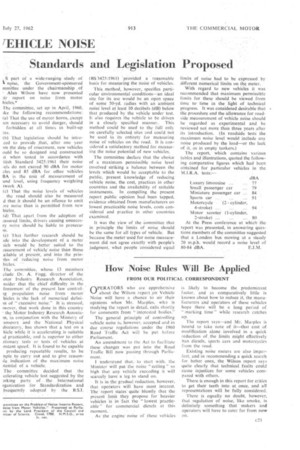Standards and Legislation Proposed
Page 61

If you've noticed an error in this article please click here to report it so we can fix it.
S part of a wide,ranging study :of noise, the Government-sponsored mmittee . under the Chairmanship . of Alan Wilson have now presented :ir report on noise from motor hides,* , The committee, set up in April, 1960, tke the following recommendations: (a) That the use of motor horns, except ien necessary to avoid danger, should forbidden at all times in built-up (b) That legislation should be introcal to provide ,that, after one year )m the date of enactment, new vehicles ould be so designed and constructed tt. when tested in accordance with itish Standard 3425:1961 their noise /els do not exceed 90 dBA for motor cies and 85 dBA for other vehicles BA is the unit of measurement of und level, using frequency weighting twork A).
(c) That the noise levels of vehicles the road should also be measured d that it should be an offence to emit ore noise than is Permitted from new hicks.
(d) That apart from the adoption of nsured limits, drivers causing unnecesry noise should be liable to prosecu
(e) That further research should be ade into the development of a meter iich would be Wetter suited to the :.,asurernent of vehiclenoise than those ailable at preSerif, and into the prin71es' of (educing noise from . motor bides.
The committee, whose 13 members elude Dr. A. FOgg; director of the• otor Industry Research Association, nsider that the chief difficulty in the forcement of the present law control prop.ulsion • noise from motor hides is the lack of numerical definiin 'of'' excessive noise." It is stressed, owever, that work done in this country the Motor Industry Research Associain, in conjunction with the Ministry of .ansport and the National Physical kboratory, has. shown that a test on a hicle while it is accelerating is suitable td practicable; and is superior to either itionary tests or tests of vehicles, at nstant speed. It is found to he capable
producing repeatable results, to be nple to carry out and to give reasonde ..indication of the maximum noise )lential of a vehicle.
The committee decided that the celerating. vehicle test suggested by the prking party of the International rganization for Standardization and bsequently adopted by the B.S.I.
(BS 3425:1961) 'provided a reasonable basis for measuring the noise of vehicles.
This Method, however, specifies particular environmental conditions—an .ideal site fOr its use would be an open space of some 50-yd. radius with an ambient noise level at least 10 decibels (dB) below that produced by the vehicle under test. It also requires the vehicle to be driven in a closely specified manner.. This method could be used to the full only on carefully selected sites and could not be used in its entirety for measuring noise of vehicles on the road. It is considered a satisfactory method for measuring the noise potential of new vehicles.
The committee declare that the choice of a maximum permissible noise level involved striking a balance between the levels which would be acceptable to the public, present knowledge of reducing vehicle noise, the cost, practices in other countries and the availability of suitable instruments. In compiling the present report public opinion had. been tapped, evidence obtained from manufacturers on lowest practicable noise levels, costs considered and practice in other countries examined.
It was the view of the committee that in principle the limits of noise should be the same for all types of vehicle. But because the meter used for noise measurement did not agree. exactly with people's judgment, what people considered equal limits of noise had to be expressed by different numerical limits on the meter.
With regard to new vehicles it was recommended that maximum permissible limits for these should be viewed from time to time in the light of technical progress. It was considered desirable that the procedure ancUthe allowance for roadside measurement of vehicle noise should be regarded as experimental and be reviewed not more than three years after its introduction. (In roadside tests the maximum noise level would include any noise produced by the load—or the lack of it, as in empty tankers.)
The report, which contains various tables and illustrations, quoted the following comparative figures which had been obtained for particular vehicles in the M.1.R.A. tests:— Luxury limousine ... 77 Small passenger car ... 79 Miniature passenger car ... 84 Sports car 91 Motorcycle (2 cylinder, 4-stroke) .„ 94 Motor scooter (1-cylinder, 2-stroke) ... „, „, 80 At the Press conference at which the report was presented, in answering questioni members of the committee suggested that a London bus moving at a steady 20 m.p.h. would retard anoise level of 80-84 dBA. E.J.M.
































































































































